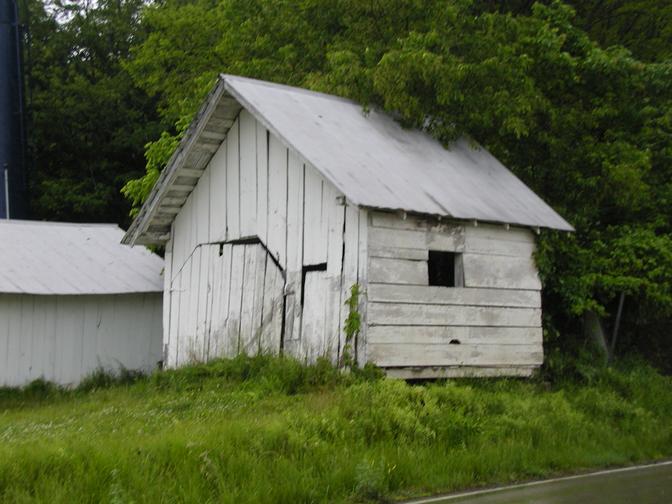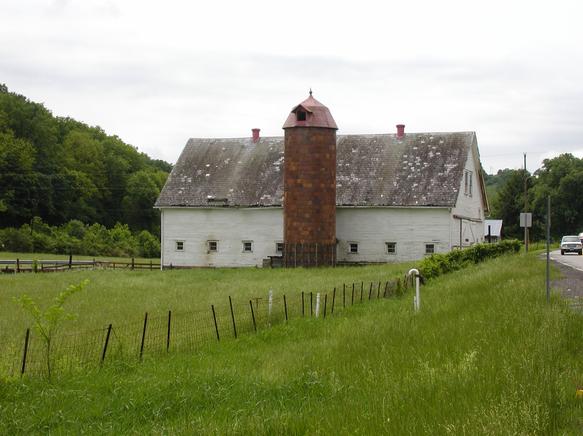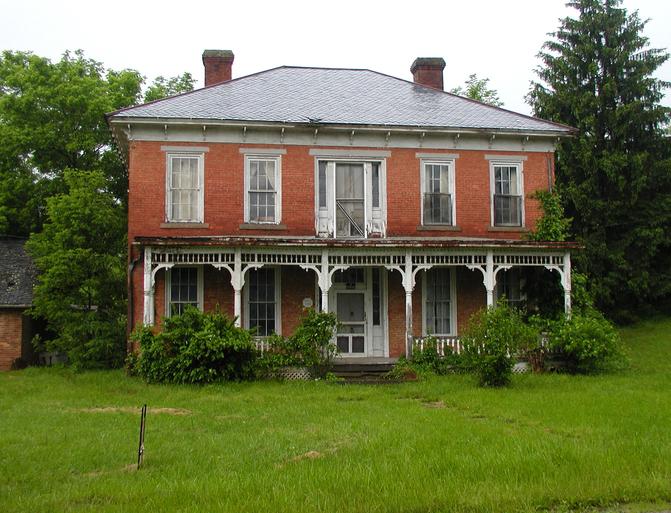
| Next Chapter | Previous Chapter | |
| Chapter 56: Fencing | Contents | Chapter 54: Going to the Sale |
The pioneers farmed as a way of life. What ever they owned came from the farm or from the surrounding woods. The principal exceptions to this were salt and iron. Even after the frontier was closed, after all ground suitable for farming was taken up, it was much the same. Manufactured goods and specialized labor had been the way of life in Europe for hundreds of years. Also, the industrial revolution took place in Europe and New England during the colonization of the Eastern Frontier.
However the difficulty of transport and the low population density on the frontier worked against the development of trade. On the frontier specialization of labor was unnecessary, to survive one could only assume the frontier culture.
Making cloth was a tremendous labor for women, in addition to all else they had to do, and surely manufactured cloth must have been one of the first items purchased off the farm. Spinning wheels are now a prized heirloom, but there are very few looms around.
One of the highest skills of the frontier was making wooden wheels. These were made precisely as they were in Egypt, several thousand years before the time of Christ. A very high skill was needed to manufacture them, so sledges were still widely in use even when I was a kid. Anyone could make a serviceable sledge with no more than reasonable care.
Today how many things you have distinguishes the wealth of a family. In the colonial and frontier periods, wealth was distinguished by workmanship, and careful home industries could take you well up
(Illustration 55-1)

Henry Bassile farm cattle scales
the ladder socially. Of course, even then great wealth was distinguished by purchased, often imported, goods, such as silverware, dishes, stylish furniture, etc. In the period between the Civil War and The Great Depression it was whether you had, on the one hand, things of home manufacture and things of community manufacture obtained by trade, or whether, on the other hand, factory made things, bought with money, that made the distinction. After the “Great Depression” there was little of local manufacture. Also, I need to mention that reading, contact with people in other places, and travel also contributed greatly to social status in the era before 1960.
Subsistence farming lasted in central Appalachia until there were markets and “up the hollows” long after that. There have never been large commercial farms in this area. General farming has been the rule, sometimes with small sales of several crops. Cattle for beef have always been of first importance for getting cash, especially in pioneer days. After towns came into existence and industry began, milk
(Illustration 55-2)

Henry Bassile’s main barn
was an important cash source until the fifties. Local milk was never sent very far, but our beef went to the big cities of the East and to Europe. There is a proud tradition in the Lost Creek area that in the 1920s the grass fattened beef from that area went to the table of the Queen of England. There was a local market for hogs, chickens, eggs, turkeys, vegetables in season, fruits (apples were quite important before the San Jose Scale, see “The Apple Business,” section 6, above) small fruits, and you could sell specialized crops like rhubarb, honey, and currants in small amounts in the local market.
A well-kept example of the facilities in the cattle business, which was the primary source of income from beyond the area is located on the old Henry Bassile place just north of Lost Creek. The Bassiles owned a very large acreage in the area. I am including pictures of the house, barn and scales, because they represent a kind of excellence in this past area. Mrs. Henry Bassile still lived when I was a child. The fourth picture is the house built by an earlier generation which stands near the Interstate highway in Lost Creek.
(Illustration 55-3)

Former Henry Bassile residence
There is no more general farming. What we do in central Appalachia would be called ranching in the West. We sell grass in the form of feeder calves and cull breeding stock (older cows, bulls, cattle too wild to keep). A very few are finished (fattened for slaughter) here, and many of those are consumed locally. The reason is that we have good grass, but do not have land to grow grain. The market one hundred years ago, even seventy -five years ago, called for grass finished cattle, which we could supply with our good bluegrass and white clover pasture. With the advent of mechanical harvest of grain and the development of feedlots, the industry changed. We produce six months to twelve month old calves and they are “finished” in states which have flat land and cheap grain. The feed lots then “finish” them. A truly obscene percentage of the cattle are now slaughtered by only three companies, something like eighty five percent.
A new innovation in the last decade has been “branded beef.” Some companies have begun wrapping cuts and selling them under a brand name. At one time beef was a “commodity,” sold by the pound, priced by the type of cut, all beef created equal, from the Argentine Pampas, Denmark, The Great Desert of Australia, or the U. S. Midwest. In recent years foreign beef has not been sold as much in the U. S., and now someone has found that people will pay more for beef wrapped in cellophane or plastic with a label on it, so that seems to be the way of the future. Elimination of small competitors is the rule of business, down to the three companies needed to avoid running afoul of the monopoly laws. It appears the future for feedlots is to prepare their animals to strict specifications written by the slaughter companies, and in turn the feed lots will control the calf producers. So much for the old free way of life of the farmer-rancher.
There are only two other industrial scale farming scenarios in West Virginia at this time. One is chickens, broilers and layers. The farmer provides land, buildings, labor including medical attention, and disposal of manure and dead birds. The company provides baby chicks, feed and a market. The farmer is locked into a deal that the company controls entirely. The broilers reach maturity in 12 to 14 weeks, and require little more than a pound of feed for each pound of chicken.
The breeding of the broiler chicks supplied to the farmers all over the country is almost as close as if they were clones. One of the most important characteristics is that they are able to survive crowded together in huge numbers. The chickens my Dad raised would kill each other if they were crowded like the ones today. Disposal of the manure is a major problem. Chicken farmers will truck it one hundred fifty miles or more for use as fertilizer, charging only for transportation
(Illustration 55-4)

A Lost Creek heirloom, the Benjamin Bassile house
The other business that is conducted on large scale is the apple business in the eastern panhandle, I know little about it, except the land is very expensive, and it is being sold for development since the area is so near Washington. Dad used to take his truck over to the eastern panhandle to get apples and peaches, which he would sell to the extended family and others. Some of this is still done.
The smaller agricultural industries (I mean exporting industries) are veal barns (mentioned above), lamb and wool production and fish culture (trout is a specialty). All else is very minor. I might say that lamb production is different in that many lambs are finished (fattened to butcher) on the farm.
Aside A fairly typical summer day would go somewhat like this: Up at 6-6:15, breakfast of cereal, fruit and medicine. Read the journal Science while eating and for a while after. Turn on the computer and check the weather. Esther watches TV, so I get snatches of news. Try to be on the job by 8:00 unless working with cattle, in which case it would be 7:00, because the cattle are more sensitive to heat than people are (they don’t sweat). You like to have the cattle work done by noon.
It usually takes half an hour to get tools or machines ready for the day before starting time, if you haven’t done it the evening before. Mornings are cooler, so heavy labor is done in the morning – set posts, use the over the shoulder brush cutter, long walks, etc. Come in for lunch at 12:00 to 12:30. Nap for an hour after lunch. Then tractor work (most often), or go for parts, or to the feed store. In for supper a little before 6:30, watch news while eating. Thank wife for good, hearty meal, which it always is.
After supper check cows and gates at the Sutton place on four wheeler, and do odd jobs with tools that can be carried there on the four wheeler, and be in by dark.
Spend evening on the net, checking on the world, and writing, maybe watch a little TV, bed at 11:00 to11:30. (I am sixty eight years old as this is written.
| Next Chapter | Previous Chapter | |
| Chapter 56: Fencing | Contents | Chapter 54: Going to the Sale |
Copyright © 1998, 2006, 2008, 2011 S. Tom Bond (stombond at hughes.net)